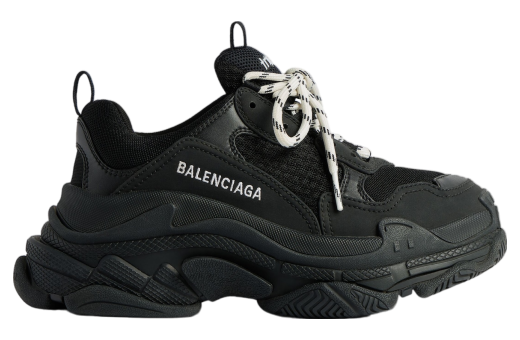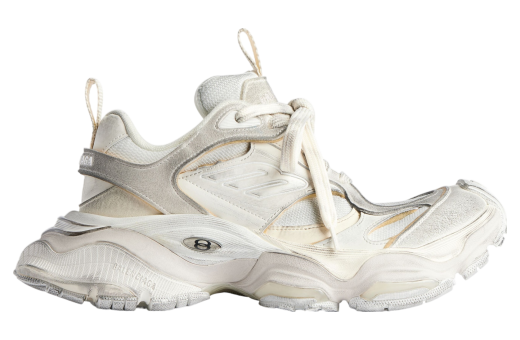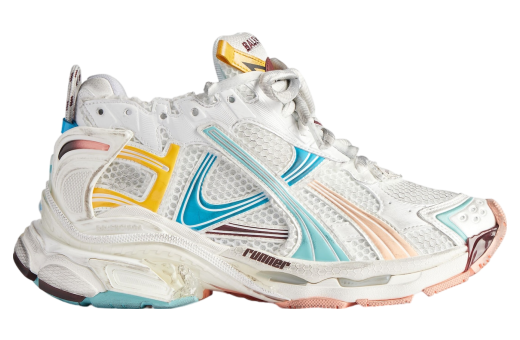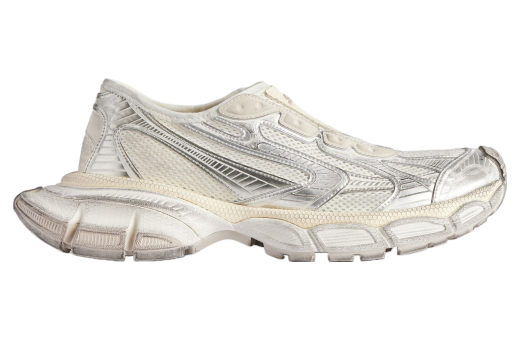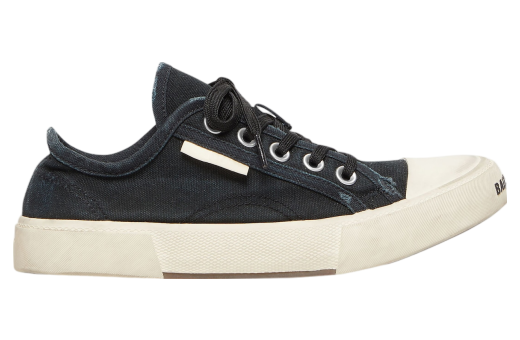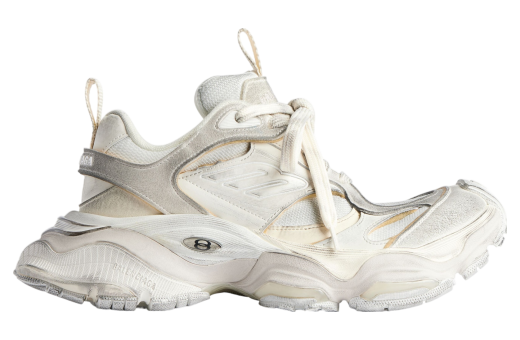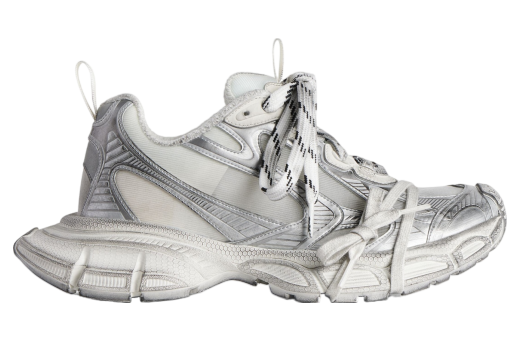Balenciaga
Balenciaga sneakers have significantly impacted the footwear industry, blending high fashion with streetwear aesthetics. Renowned for their bold designs and avant-garde approach, these sneakers have transcended the conventional boundaries of athletic footwear. The brand’s most iconic models, such as the Triple S and the Speed Trainer, illustrate a unique ethos that combines luxury and functionality. The Triple S, with its chunky silhouette and layered sole, has become a status symbol, celebrated for its exaggerated proportions and intricate detailing. The Speed Trainer, on the other hand, offers an entirely different appeal with its minimalist, sock-like construction that provides unparalleled comfort and a sleek, futuristic look. Both models showcase Balenciaga's commitment to innovation and craftsmanship, elevating sneakers from everyday wear to high-fashion staples.
Beyond their aesthetic appeal, Balenciaga sneakers reflect deeper cultural and social trends, particularly in how they bridge various subcultures and demographic groups. The brand’s distinctive designs serve as a canvas for self-expression among fashion-forward individuals, enabling wearers to make bold statements about their personal style. By integrating high-quality materials and cutting-edge technology, Balenciaga ensures that performance and durability match their visual impact. Additionally, these sneakers have become a global phenomenon, prominently featured on social media platforms and endorsed by numerous celebrities and influencers. This widespread visibility has cemented Balenciaga's position in the luxury sneaker market, transforming how people perceive and engage with high-end footwear. As a result, Balenciaga sneakers have not only redefined sneaker culture but also contributed to the growing acceptance of luxury streetwear in mainstream fashion.
History of Balenciaga
History of Balenciaga: The Haute Couture Evolution
Introduction
Balenciaga is a name that resonates with sophistication, innovation, and unparalleled vision in the fashion industry. Founded by Spanish designer Cristóbal Balenciaga in 1917, the house of Balenciaga has emerged as one of the most iconic and revolutionary fashion brands in history. Over more than a century, it has continued to push the boundaries of fashion design, influencing countless designers and leaving an indelible mark on the way we perceive clothing.
Early Years and Formation (1917-1936)
Cristóbal Balenciaga was born in the small fishing village of Getaria, Spain, on January 21, 1895. From an early age, he was captivated by fashion, learning the trade from his mother, a seamstress. His inherent talent led to apprenticeships in Spain where he honed his skills. By the time he opened his first boutique in San Sebastián in 1917, Balenciaga had already begun to establish his reputation.
In the early years, Balenciaga's designs were influenced heavily by the Spanish Renaissance and the sartorial splendor of the Spanish court. His adept ability to innovate traditional styles attracted the Spanish royal family and aristocrats. During this period, he opened additional boutiques in Madrid and Barcelona, further solidifying his influence in Spanish fashion.
Exile to Paris and International Acclaim (1937-1950s)
The Spanish Civil War (1936-1939) forced Balenciaga to close his boutiques and relocate to Paris in 1937. There, he opened a couture house at 10 Avenue George V. Paris, the epicenter of fashion, provided the perfect backdrop for Balenciaga's talent to flourish. His first collection in Paris was revolutionary, earning immediate acclaim and establishing him as a designer of unparalleled skill and vision.
Through the 1940s and 1950s, Balenciaga solidified his position as an industry leader. He was known for his precise tailoring, innovative cuts, and architectural approach to garment construction. His work in these years laid the foundation for many of the principles that would shape modern fashion. He became particularly known for his revolutionary silhouettes, such as the barrel line, the semi-fitted suit, and the tunic dress.
Fabrics played a crucial role in Balenciaga's designs. He often worked with unusual materials that others avoided, such as heavy brocades and bold florals, pushing the limits of the conventional understanding of fabric utility in haute couture. His impeccable attention to detail and dedication to craftsmanship elevated his work to a level few could match.
The Golden Age (1950s-1960s)
The post-war era marked the golden age of Balenciaga, where he introduced some of his most celebrated designs. The 1950s saw the emergence of the "balloon jacket," the "sack dress," and the "high-low hemline" – all designs that deviated significantly from the era's fashion norms. He was a stubborn individualist, unafraid to challenge the trends endorsed by other Parisian couturiers.
One of Balenciaga's most iconic creations during this period was the "baby doll" dress, which introduced an entirely new silhouette to women's fashion. It was characterized by its loose fit and shorter hemline, bringing a sense of playful rebellion to the otherwise structured fashion of the 1950s.
The 1960s brought even more innovation. Balenciaga’s use of bold, architectural shapes in designs like the "envelope dress" and "balloon skirt" baffled and delighted the fashion world. Furthermore, his refusal to conform to the norms bolstered his status as a fashion visionary. Often, he would work for months on a single collection, meticulously considering every detail down to the last stitch. This period was also marked by an increased use of black and a minimalist approach, a stark contrast to the more opulent trends of earlier years.
Final Years and Closure (1960s-1970s)
The fashion landscape began to change in the late 1960s. Ready-to-wear clothing was becoming increasingly popular, and the emergence of youth culture brought a wave of new trends that clashed with the established norms of haute couture. Yet, Balenciaga held steadfast to his principles of handcraftsmanship and innovative design.
In 1968, Cristóbal Balenciaga announced his retirement, claiming that fashion was becoming an art form dominated by commercial interests rather than true artistry. He closed his fashion house and spent his remaining years in his native Spain, away from the limelight. Balenciaga passed away on March 23, 1972, leaving behind a legacy that would be a gold standard for future generations of designers.
Revival and Rebirth (1980s-Present)
After Balenciaga's death, the brand went through a period of dormancy. It wasn’t until the 1980s that Jacques Bogart S.A. acquired the rights to Balenciaga and sought to revive the once-great house. This period saw moderate success, but it wasn't until the appointment of Nicolas Ghesquière as creative director in 1997 that Balenciaga truly returned to the forefront of the fashion industry.
Ghesquière's arrival marked a turning point, as he reinterpreted Balenciaga’s archival pieces through a modern lens. His designs were characterized by their futuristic aesthetic, innovative use of fabrics, and a nod to Balenciaga's historical silhouettes. Under his direction, the brand regained its status as a leading fashion house, introducing iconic collections that captivated both the fashion industry and the public.
In 2012, Ghesquière left Balenciaga, and American designer Alexander Wang took over as creative director. Wang's tenure brought a youthful, urban edge to the brand, but it was relatively short-lived, ending in 2015. Following Wang's departure, Demna Gvasalia, co-founder of the cult brand Vetements, was appointed as the new artistic director.
Gvasalia’s approach to Balenciaga has been both revolutionary and controversial. His focus on deconstruction, streetwear influences, and social commentary has resonated strongly with contemporary audiences, particularly millennials. He has brought the brand into the digital age with innovative marketing strategies and collaborations that have captured a global audience.
Under Gvasalia, Balenciaga has become synonymous with the high-fashion streetwear movement. Collections featuring oversized silhouettes, logo-heavy designs, and unique interpretations of everyday items have set new trends and fueled debates about the nature of fashion and luxury.
Legacy and Influence
Balenciaga’s enduring influence on the fashion world cannot be overstated. Cristóbal Balenciaga was often referred to as the "master of us all" by fellow designers. His commitment to innovation, craftsmanship, and artistic integrity set a benchmark in haute couture. His teaching has profoundly influenced legendary designers such as Christian Dior and Hubert de Givenchy.
In modern times, under the guidance of designers like Ghesquière and Gvasalia, Balenciaga has continually explored and expanded the limits of fashion. The brand’s ability to reinvent itself while maintaining its core values of innovation and craftsmanship speaks volumes about its resilience and relevance in an ever-changing industry.
Balenciaga’s success is not just attributed to its designs, but also to its adaptability and forward-thinking approach. The brand has adeptly navigated the shifts in the fashion landscape, from haute couture to ready-to-wear, and from traditional fashion shows to digital platforms.
Conclusion
Balenciaga's history is a testament to the enduring power of vision, creativity, and artistry in fashion. From Cristóbal Balenciaga’s pioneering designs in the early 20th century to the modern, avant-garde creations under Demna Gvasalia, Balenciaga has always been at the cutting edge of fashion innovation. Its legacy is a blend of rigorous craftsmanship and bold experimentation, a balance that has kept the brand relevant through the decades.
Balenciaga continues to chart new territory, captivating audiences and influencing designers across the globe. Its history is not just a chronicle of past achievements but a continuous evolution that promises to shape the future of fashion.

